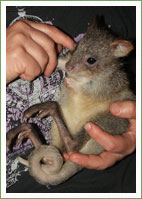Blog
Contact media@wires.org.au for enquiries or call 0416 272 153.
For the latest updates on bushfire recovery projects and emergency response
Read WIRES Emergency Recovery Plan and WIRES National Emergency Response Plan
Rufous or Rat?
 When a farmer in northern NSW noticed the body of a dead rat close to
the house he thought little of it. However when later that day the dead
rat hopped up to him he was more than a bit surprised and also realised
it was no rat.
When a farmer in northern NSW noticed the body of a dead rat close to
the house he thought little of it. However when later that day the dead
rat hopped up to him he was more than a bit surprised and also realised
it was no rat.
WIRES was called and Kim and Debra collected the little fellow which turned out to be a juvenile Rufous Bettong which is a vulnerable species in the macropod family, vulnerable due to loss of habitat. He will need to be in care for some time until he is old enough to be returned back to his area where he can help ensure the continuance of his species in our environment for many years to come.
These small macropods are quite different to other macropod species. They build nests and even though this little fellow is only a juvenile, he started building nests within a few days of being in care. They sleep during the day in conical grass nests built on a shallow depression at the base of a tussock or a fallen log. They feed on grasses, herbs, tubers, roots, fungi & some insects. Apart from mothers with young, they are solitary in the wild.
They have a prehensile tail which they use to carry grasses gathered for nesting.
As he needed to settle down to being in care before he could be put in to the larger outside enclosure it was assumed he would be happy in a substitute pouch until he was moved outside.That proved not to be how he saw the situation, within two days of coming in he started on the first nest and within a few days he had built three, allowing him to change nest when ever he felt the need and Kathy was growled at each time she came close in order to feed him.
He was moved out to the large outside enclosure after about 10 days as he was quite settled and his nests were moved with him. Other macropods in care in the same enclosure are slowly learning not to come too close to his nests as they will be told of in no uncertain terms by loud growls coming from within.
Image credit Rachel Grieveson, story thanks to WIRES Northern Rivers Branch
Search
Newsletter
Stay in touch and get our regular rescue stories, WIRES updates and a free copy of our 15 Ways to Help Wildlife ebook
Recent Posts
- Emergency Response Training for Wildlife Volunteers
- WIRES Introduces New Wildlife Rehabilitation Governance Courses in Collaboration with NPWS
- Community Support for Post-Bushfire Recovery of Wildlife in the Greater Blue Mountains
- Research Grants Program-2023 Recipients Announced
- National Koala Conference
- Nature Conservation Council's Bushfire Conference
- Support Stronger Nature Laws
- Helping Endangered Cockatoos: WIRES Grant Success Story
- Landmark Conservation Project Ensures The Future of The Northern Bettong
- Wildlife Road Collisions Unveiled
